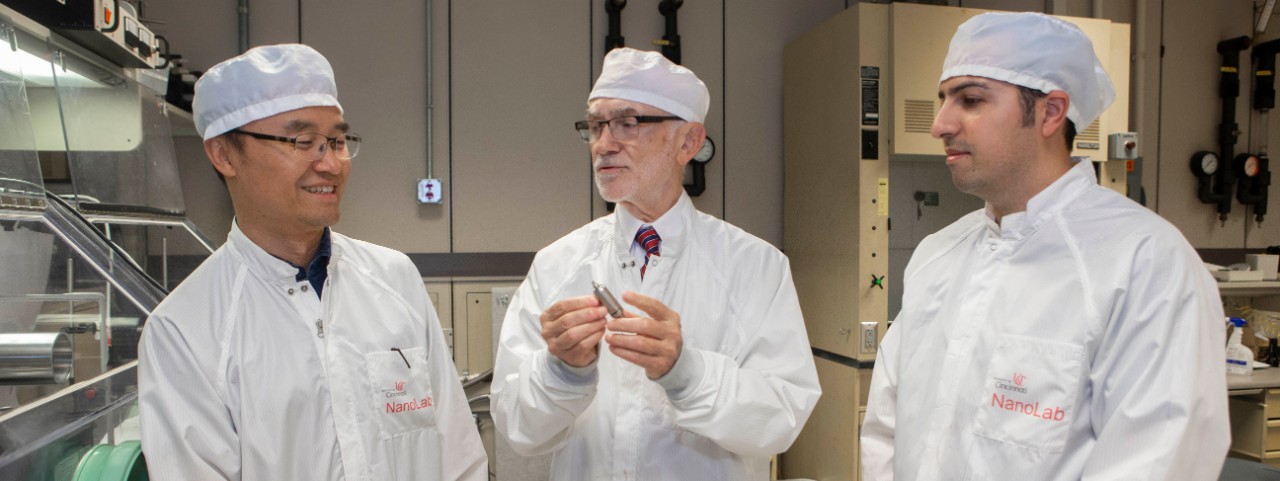
Spectrum News: UC develops new medical apps
Engineering professor Andrew Steckl is developing new applications for the fabrication process
University of Cincinnati engineering professor Andrew Steckl spoke to Spectrum News 1 about promising medical innovations he is developing using century-old technology.
Steckl, a professor of electrical engineering in UC's College of Engineering and Applied Science, is working on new treatments for brain tumors and cancer using a fabrication process called coaxial electrospinning. It combines two or more materials into a fine fiber for use in industry, textiles or even medicine.

Coaxial electrospinning creates a spiderweb-thin fiber. UC is using unique combinations of polymers to develop new medical treatments. Photo/Joseph Fuqua II/UC Creative Services
In the clean room of his Nanoelectronics Laboratory, Steckl creates spiderweb-thin fibers with a core of one material surrounded by a sheath of another. Through unique combinations, he can take advantage of the properties of one material with the powerful benefits of another.
“It’s a bit of complicated physics,” Steckl told Spectrum 1 News. “When you combine the forces of an electric field with the viscous forces of a fluid, you create a very fine jet. It’s stable for a bit and then it becomes unstable and begins to spin around – hence, electrospinning.”
Electrospinning was invented in 1902 for use in textiles. But Steckl has been applying it to medical applications for new drug-delivery systems and novel treatments for a brain tumor called glioblastoma.
Steckl said electrospun pharmaceuticals could release fast-acting painkillers through the outer fiber layer while the inner layer would provide a longer-lasting or slow-release therapeutic drug.
Featured image at top: University of Cincinnati professor Andrew Steckl, center, talks with UC senior research associate Daewoo Han, left, and Turkish researcher Serdar Tort in Steckl's Nanoelectronics Laboratory. Photo/Joseph Fuqua II/UC Creative Services
More news coverage of UC's research
- Science Daily: Electrospun fibers weave new medical innovations
- The Verdict: The 100-year-old manufacturing technique set to revolutionize medicine
- SciTechDaily: Not Spiderwebs: These Electrospun Fibers Weave New Medical Innovations
- MedGadget: Coaxial Electrospinning Creates Novel Contraceptive, Other Devices
Become a Bearcat
- Apply online or get more information about undergraduate enrollment by calling 513-556-1100.
- Learn more about UC's many undergraduate and graduate programs.
Related Stories
UC celebrates record graduating class at commencement
April 25, 2024
UC celebrated its doctoral hooding and master's recognition ceremony at Fifth Third Arena as part of its three-day commencement for the largest graduating class in university history.
UC education allowed couple to make mark on Cincinnati
April 24, 2024
As a native of Defiance, Ohio, John Deatrick, CEAS ’79, says arriving in Cincinnati to attend the University of Cincinnati in 1963 felt like landing in New York City.
Engineering student studying flight physics of birds
April 24, 2024
After earning a bachelor's degree in mechanical engineering in Nepal, Sameer Pokhrel came to the United States to further his education. From an early age, he had a lifelong fascination with aviation. As an adult, he transformed this fascination into a career, pursuing a doctoral degree in aerospace engineering at the University of Cincinnati's historic program. Here, he has succeeded in research, instruction, and was recently named Graduate Student Engineer of the Month by the College of Engineering and Applied Science.

